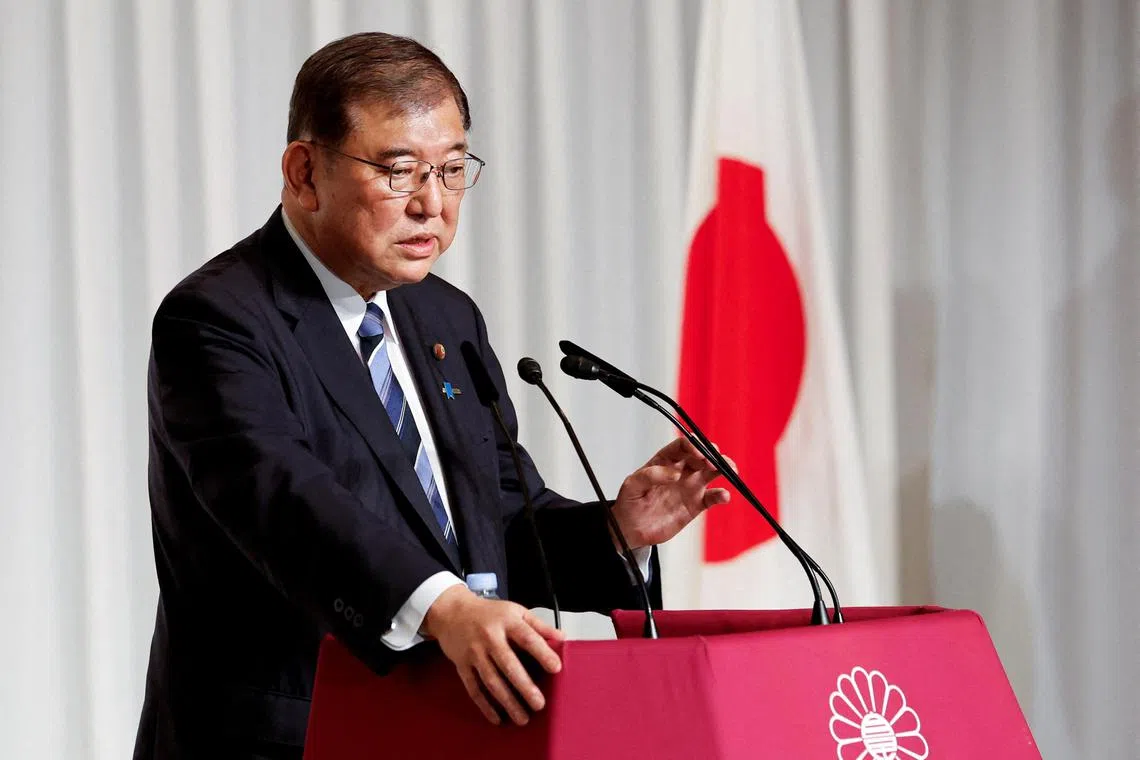Five challenges facing Japan’s new PM Ishiba
Sign up now: Get insights on Asia's fast-moving developments

Incoming PM Shigeru Ishiba wants to boost Japan’s defence capabilities and proposes an “Asian Nato” to counter threats, including North Korean missile tests.
PHOTO: REUTERS
Follow topic:
TOKYO – Mr Shigeru Ishiba will face five key challenges when he becomes Japan’s new prime minister on Oct 1 after being voted leader of the ruling Liberal Democratic Party (LDP).
1. Security threats
Nerves are running high over China’s increasingly aggressive moves in the region, following the first confirmed incursion by a Chinese military aircraft
Other incidents have soured relations since then, including the fatal stabbing of a Japanese schoolboy
Mr Ishiba, a security policy expert, wants to boost Japan’s defence capabilities and proposes an “Asian Nato” to counter threats, including North Korean missile tests.
The incoming premier also wants a more equal alliance with the US, but there is “no need to hyperventilate about the prospects for dramatic change” in defence policy, said Mr Nicholas Szechenyi of the Centre for Strategic and International Studies.
“The rapidly deteriorating security environment in Asia favours more security cooperation with the United States and other partners,” he added.
2. LDP scandals
Outgoing Prime Minister Fumio Kishida has record-low approval ratings, partly due to scandals over party funding
Mr Ishiba, who intends to call a snap election
“(Ishiba’s) ability to reflect the popular mood was evident earlier this year in his criticism of his party’s response to the political funding scandal,” said Dr James Brady of consulting firm Teneo.
But a general election could also rehabilitate some disgraced party members, said Dr Naofumi Fujimura, a professor at the Graduate School of Law at Kobe University.
“In Japan, if you win an election, you are considered to be purified,” he told AFP, adding that due to this, some MPs involved in the scandals “may return to the public stage”.
3. Lacklustre economy
Sluggish consumption and wage growth have long been a drag on growth in Japan.
Mr Ishiba backs the Bank of Japan’s gradual move away from its maverick ultra-loose policies – a stance that caused the yen to surge after his victory in the LDP vote, which, in turn, led Japanese stocks to tank on Sept 30.
His win “implies less pressure... for large-scale debt-funded spending or a return to monetary easing by the Bank of Japan”, policies championed over a decade ago by former premier Shinzo Abe, said Teneo’s Dr Brady.
To help the government’s existing plan to ramp up defence spending to 2 per cent of gross domestic product by 2027, Mr Ishiba has suggested a hike in corporate taxes
4. Ageing population
Japan has the world’s oldest population after tiny Monaco, and its population aged 100 or older is at a record high of more than 95,000, recent data shows.
Mr Ishiba aims to raise Japan’s low birth rate through measures including a review of the country’s notoriously long working hours and expanding support for parents.
He has called the revitalisation of rural regions – where shrinking elderly communities are becoming increasingly isolated – “my life’s work”, along with security and disaster prevention.
5. Climate policy
Japan is targeting carbon neutrality by 2050
The E3G think-tank ranks Japan in last place – by some distance – among Group of 7 nations on efforts to reduce emissions from their power systems, with the highest reliance on fossil fuels.
Economist and former Bank of Japan board member Sayuri Shirai told AFP that Japan needs to focus more on decarbonisation strategies, especially in business.
If Japanese companies do not do that, “they will lose out to global competition” because high-carbon emission goods could be punished with taxes and tariffs, she said. AFP

